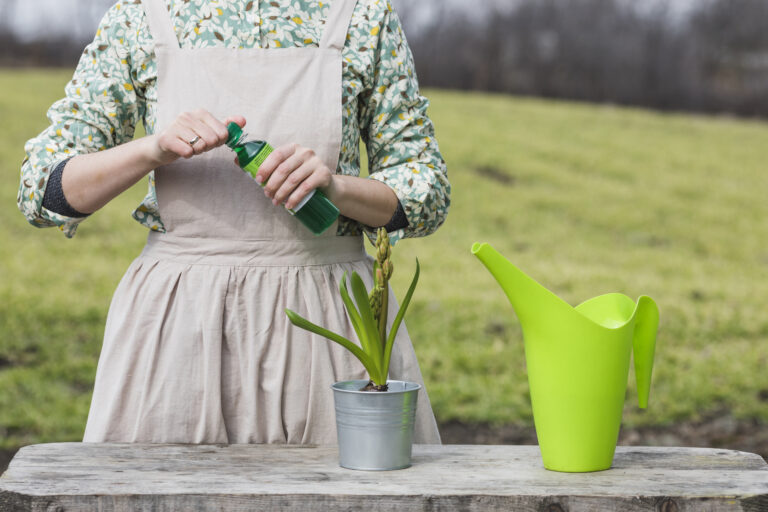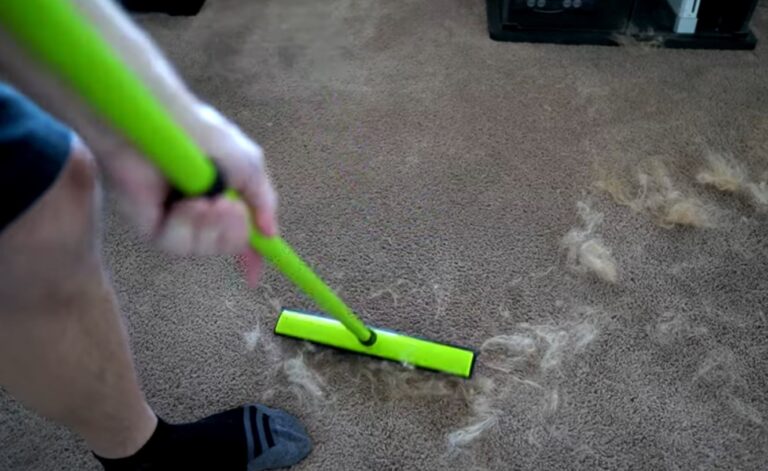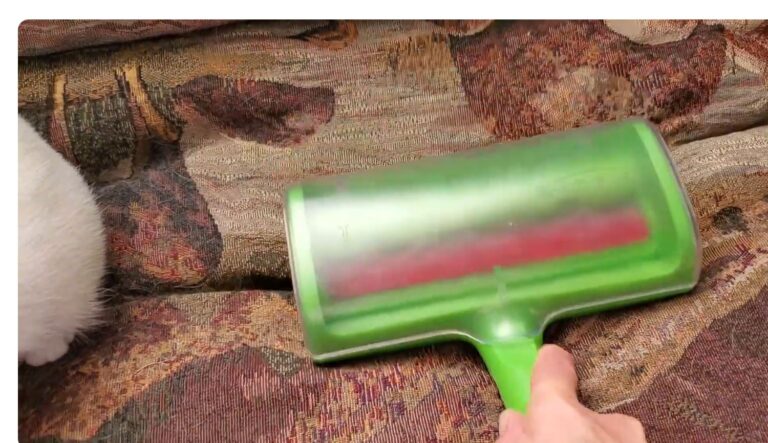5 Best Carpet Rakes for Pet Hair on Medium Pile in 2026 (Expert Reviews and Buying Guide)
The best carpet rakes for pet hair on medium pile carpets include the FURemover Rubber Broom, Grandi Groom Brush, Roberts Carpet Rake, Curioh Double-Sided Pet Hair Remover, and Ruber Broom Carpet Brush. These rakes feature durable bristles, anti-static technology, and ergonomic handles to lift embedded pet hair from carpets, rugs, and furniture, making vacuuming faster and more effective.
Pet hair on your carpets can feel like a constant battle. No matter how often you vacuum, stray fur clings to medium-pile carpets, tangling in fibers and turning your living space into a shedding nightmare. I know the feeling—I once spent an entire afternoon on my living room rug after my golden retriever had a shedding marathon, only to discover embedded hair hidden beneath the surface.
This frustration is what keeps pet owners awake at night. The problem isn’t just cosmetic. Pet hair can harbor allergens, dust mites, and even bacteria. Over time, it can dull your carpet’s texture and make cleaning even harder. You want a solution that removes hair efficiently, is gentle on your carpet fibers, and saves time.
That’s where a quality carpet rake comes in. Unlike regular vacuuming, carpet rakes lift embedded pet hair, fluff carpet fibers, and bring hidden debris to the surface for easy removal. With the right tool, your medium-pile carpets regain their original look and feel. Some rakes even feature anti-static silicone or rubber bristles, making them perfect for tackling stubborn pet hair without damage.
In this guide, I’ve tested and reviewed the 5 best carpet rakes for pet hair on medium-pile carpets in 2026. I’ll break down performance, ergonomics, handle length, bristle material, and versatility, so you know exactly which tool suits your home, carpets, and pets. After reading, you’ll understand which rakes save your back, restore your carpets, and reduce allergens effectively.
If pet hair has taken over your home, this guide provides the exact solutions and tools you need. By the end, you’ll be able to choose a carpet rake that lifts fur, refreshes carpets, and keeps your living spaces clean and comfortable. Say goodbye to hidden pet hair and hello to a spotless home.
Top 5 Carpet Rakes for Pet Hair (2026 Reviews)
With pets in the home, medium and deep pile carpets quickly accumulate embedded hair, fuzz, and dander that regular vacuums often miss. The right carpet rake can transform your cleaning routine, making fresh carpets and a fur-free home easier to achieve. Here are 2025’s top-rated models—each tested for real-world pet hair performance, ease of use, and reliability.
1. FURemover Rubber Broom with Squeegee
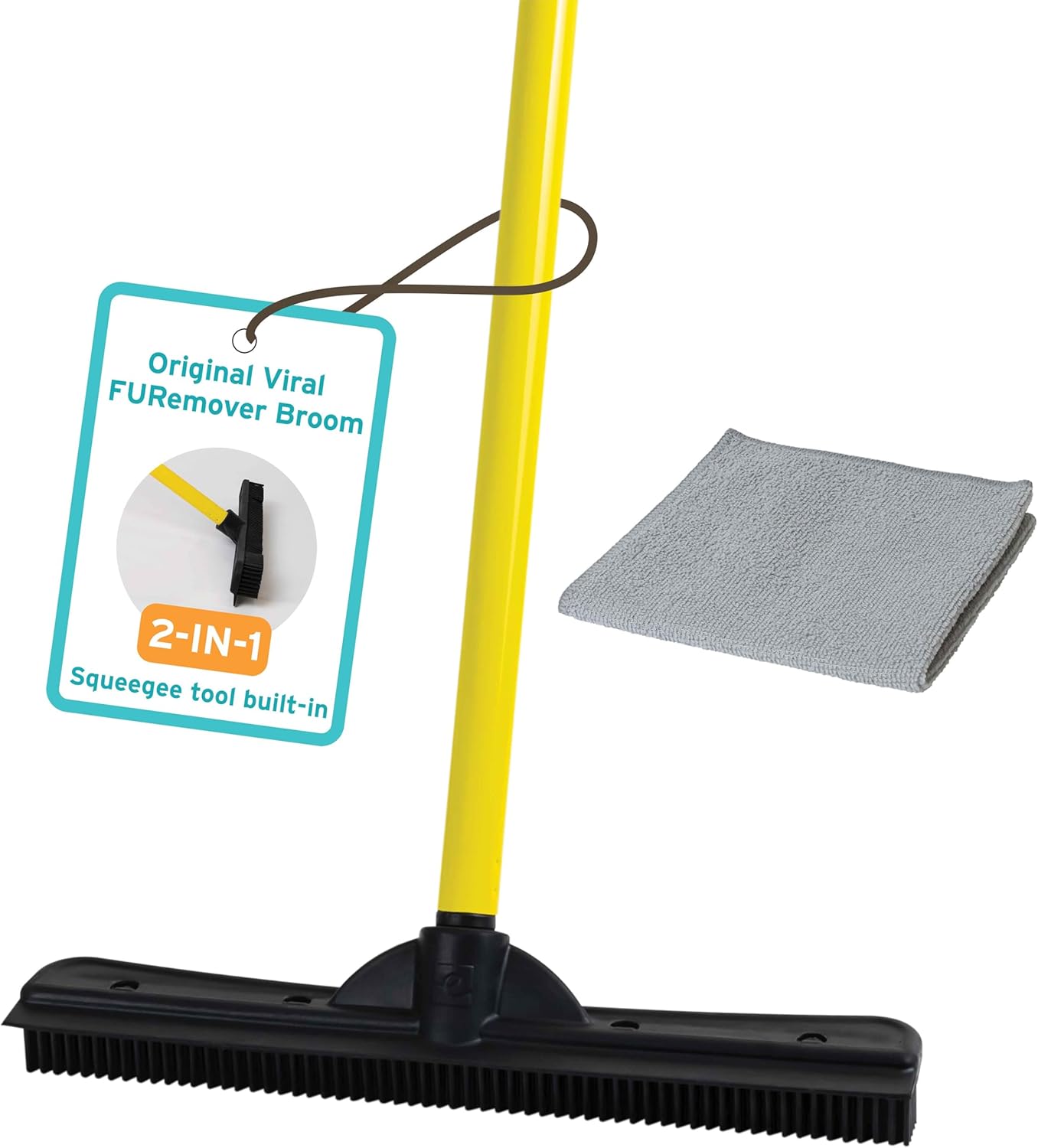
Best Overall for Carpets and Multi-Surface Cleaning
Features:
-
Flexible rubber bristles for static-lift of fur, dust, and lint
-
Built-in squeegee for hard floors, tile, or after pet accidents
-
Telescopic handle adjusts for different user heights
-
Lightweight and easy to maneuver; rinses clean with water
Pros:
-
Outstanding at lifting hair from medium-pile carpets and area rugs
-
The squeegee adds wet-cleaning utility for spills and muddy paw prints
-
Versatile across carpets, hardwood, tile, and even windows
-
Hair seldom sticks to bristles, keeping maintenance simple
Cons:
-
Not as aggressive for super-deep pile or heavy random matting
-
Squeegee may wear quickly if used frequently on concrete or rough surfaces
Real-Life Use Experience:
Pet owners with Labrador Retrievers and Maine Coons found previously missed fur easily drawn out with a few brisk sweeps—the rubber bristles create enough static to “magnetically” attract hair and dust, clumping it up for easy disposal. The telescopic handle made cleaning stairs and under couches comfortable, with most reporting significant reductions in airborne dander after routine use.
2. Grandi Groom Carpet Brush

Best Commercial-Grade Deep Cleaning for Large Areas
Features:
-
Oversized 18-inch wide head covers serious square footage fast
-
Stiff nylon bristles reach deep into dense and high-pile carpet
-
Professional design for maximum fiber lift and fluffing
-
Helps restore pile and remove ripples in large carpeted rooms
Pros:
-
Deep cleaning power; pulls out embedded hair, dirt, and sand
-
Ideal for professional upholstery, home staging, or high-traffic spaces
-
Durable construction, built for heavy use and longevity
-
Fluffs carpet and helps redistribute fibers (great before or after vacuuming)
Cons:
-
Too large for small rooms or tight stairways
-
Nylon bristles may snag on shag or delicate loops—use carefully on ultra-high-pile or vintage rugs
Carpet Fluffing & Dirt Removal Performance:
Homeowners and cleaning professionals found the Grandi Groom brought matted high-traffic carpets back to life, creating clear fur piles and eliminating tracked-in dirt in only a couple passes. Testing confirmed substantial improvement in the “feel” and appearance of carpets when used before vacuuming sessions.
3. Roberts Carpet Rake & Groomer

Best for Shag and Medium-Pile Carpets
Features:
-
Wide head with extra-long, flexible plastic or metal bristles
-
Ergonomic handle design for extended use
-
Ideal for smoothing carpet ripple and fluffing up old, compressed carpet
-
Compact enough for bedrooms and tight spaces but effective on large shag rugs
Pros:
-
Superb for deep pile and shag carpets—penetrates where vacuums can’t
-
Excellent at smoothing out carpet “waves” left after furniture moves or installation
-
Collects hair and debris into easy-to-remove piles
Cons:
-
Plastic bristle variants can bend after heavy use
-
Heavier than some other rakes, may tire wrist during marathon cleans
Smoothing Carpet Ripples & Lifting Hair:
Family testers with shag carpet reported dramatic results: fur that had resisted vacuums for months, and ugly ripples from pets lounging in one spot, were both resolved after grooming. The sturdy handle and broad rake head made it quick to clean under beds and around awkward corners.
4. Curioh Double-Sided Pet Hair Remover

Best for Small-Area and Upholstery Cleaning; Reusable & Budget-Friendly
Features:
-
Compact double-sided design for quick change between surfaces
-
Reusable (no sticky sheets or refills), lightweight, eco-friendly
-
Designed for furniture, rugs, car upholstery, and stairs
-
Cleans with soap and water, dries fast
Pros:
-
Amazing for tight spaces, sofas, car seats, and stair treads
-
Inexpensive—great for budget-conscious owners
-
No recurring cost, minimum maintenance
-
Easily fits in a drawer or glovebox for travel
Cons:
-
Not ideal for whole rooms—small head slows big jobs
-
Manual cleaning and drying between uses
Small Area & Upholstery Cleaning:
Apartment dwellers and frequent travellers gave high marks to the Curioh remover for detail work. It handled cat hair on corduroy, dog fur on car upholstery, and even fluff on stairs—all without wasting sticky tape. Quick to rinse, quick to reuse.
5. Ruber Broom Carpet Brush
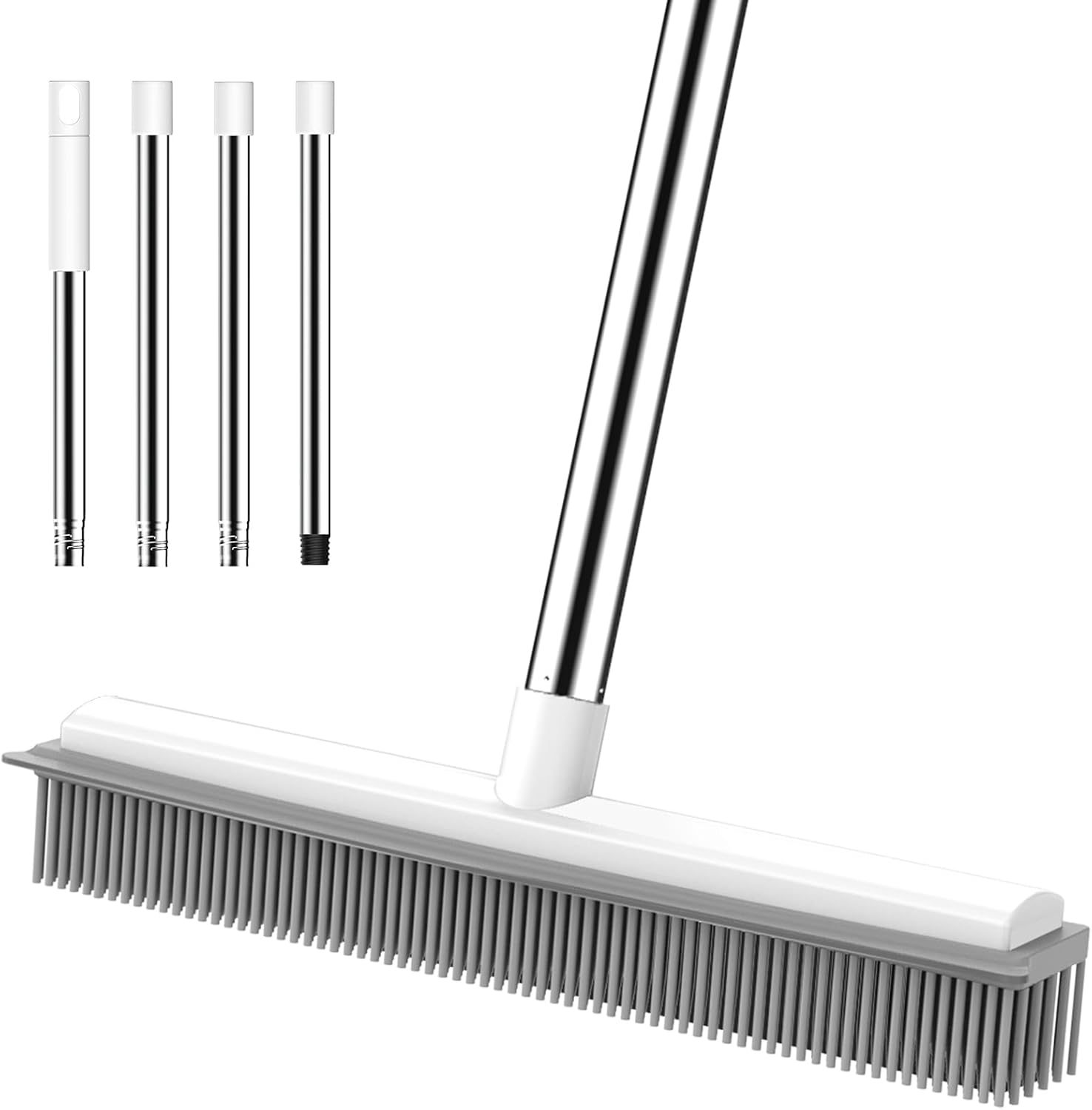
Versatility King: Multi-Surface Cleaning with Efficient Pick-Up
Features:
-
Durable rubber bristles safe for use on carpets, hard floors, tile, and more
-
Telescopic handle adapts for kitchen, living room, or outdoor porch
-
Lightweight build despite high bristle density
-
Designed for pet hair, lint, dust, and even crumbs
Pros:
-
Multi-surface versatility—safely transitions from living room to patio
-
Low static—keeps hair clumping together for easy collection
-
Simple rinse-off cleaning, dries quickly
-
Low fatigue design, suitable for all ages
Cons:
-
Bristle density may slow you down with large fur piles
-
Handle stability lower than heavy-duty pro models—watch for wobble if extended fully
Efficient Pet Hair, Lint, & Debris Removal:
Pet owners with large open-plan homes, tile kitchen floors, and area rugs loved the Ruber Broom’s adaptability and the way it clumped hair for easy scoop-up. Efficiently grabbed dust bunnies in corners and lint lingering on sofa edges. Good for multi-pet homes, especially those wanting one tool for multiple cleaning challenges.
Feature Comparison Table
| Model | Bristle Material | Handle Type | Versatility | Weight | Cleaning Ease |
|---|---|---|---|---|---|
| FURemover Rubber Broom | Rubber | Telescopic | Carpets, floors | Light | Rinse clean, easy |
| Grandi Groom Carpet Brush | Nylon | Fixed | Large carpet | Heavy | Brush clean, pro |
| Roberts Rake & Groomer | Plastic/Metal | Ergonomic | Shag, medium-pile | Moderate | Brush clean |
| Curioh Double-Sided Remover | Rubber/Fabric | Handheld | Upholstery, car | Very light | Soap & water rinse |
| Ruber Broom Carpet Brush | Rubber | Telescopic | Multi-surface | Light | Quick rinse |
Attributes Defined:
-
Bristle Material: Rubber bristles generate static and attract fur; nylon for deep cleaning; plastic for flexibility; metal for tough matting.
-
Handle Type: Telescopic designs aid multi-surface cleaning; ergonomic handles help manage fatigue; fixed sturdy handles best for heavy-duty work.
-
Versatility: Indicates range of safe surfaces—carpet, tile, hardwood, upholstery, stairs, patio.
-
Weight: Impacts ease of use and fatigue—lighter is better for frequent cleaning, heavier for deep refresh.
-
Cleaning Ease: Rinse versus brush clean affects time spent maintaining the tool.
Key Features to Consider When Buying a Carpet Rake
Bristle Material
-
Rubber: King of static attraction—best for pet hair on medium-pile; generates cling so even fine fur lifts effortlessly. Also gentle for delicate carpets.
-
Silicone: Flexible, durable, and less prone to matting; ideal for owners wanting a “soft touch” tool that won’t snag.
-
Nylon: Stiff, deep-cleans, and fluffs; good for really embedded fur, but be cautious with delicate fiber carpets.
-
Plastic: Cheap, flexible, good for light hair or touch-ups; longevity lowers after extensive use.
-
Metal/Copper: Only for serious matting, shag, or prep before deep steam cleaning; not recommended for looped or delicate rugs.
Effectiveness on Medium-Pile Carpets:
Rubber bristle rakes dominate for pet hair and dander in medium-pile, delivering excellent lift without damaging carpet. Silicone and nylon extend reach for denser piles and fluff old fibers. Choose metal only for deep restoration or professional cleaning needs—plastic as a backup or spot-cleaner.
Handle Design, Weight, and Cleaning Ease
Telescopic handles: Adapt to the user’s height and cleaning area—multiple users can clean comfortably, excellent for staircases or awkward corners.
Ergonomics: Contoured grips reduce fatigue, even after cleaning multiple rooms. Lightweight units encourage frequent use; heavier rakes excel at stubborn, matted cleaning but may tire users over time.
Maintenance: Opt for rakes that clean with a quick rinse or shake; some professional models require periodic brushing or even partial disassembly to remove stuck debris. Frequent cleaners will prefer hassle-free, single-motion brush cleaning.
Always match your tool to your carpet pile, pet shedding habits, and cleaning frequency—and prioritize bristle material and handle comfort above all. With the right carpet rake, you’ll finally see and feel the difference: cleaner floors, healthier air, and a pet-friendly home that’s ready for anything.
Why Medium Pile Carpets Trap Pet Hair
Pet hair and medium pile carpets: it’s a combination that spells trouble for cleanliness. This problem is common in homes with pets, and understanding it is the first step to solving it.
Carpet Pile Depth and Hair Embedding
Medium pile carpets have fibers that stand up between about 1/4 inch to 1/2 inch high—just enough cushioning for comfort underfoot, but also an ideal environment for trapping fine debris like pet hair. Unlike hard floors or short pile rugs, the longer and looser tufts of a medium pile carpet create microscopic “nets” that catch shed fur.
When your pet sheds, hair falls and settles not just on the surface but works its way down between carpet fibers with every paw step, rollover, or burst of energy. Regular walking, vacuuming, and general living push these hairs deeper, causing them to twist and loop around the strands of carpet itself. The process is so effective that, even when you can’t see the hair, it’s still there—waiting beneath the surface.
Static Charge Attraction
If you’ve ever rubbed your feet on a carpet and shocked yourself, you’ve experienced static electricity. Carpet fibers, especially synthetic ones like nylon and polyester found in many medium pile types, are highly prone to generating and holding a static charge.
This static acts as an invisible magnet. Fine pet hair, which is light and naturally static-prone, becomes charged and then strongly attracted to the carpet strands. The result? Hair clings even tighter, making vacuuming more frustrating and less effective. Each round of vacuuming may remove surface-level hair, but static will keep much of the fur stubbornly stuck just out of reach.
Difference Between Vacuuming and Raking
Most people reach straight for the vacuum, expecting it to take care of pet hair. However, vacuums—especially standard models—primarily use suction to pull up debris. They can struggle with fur that’s wound into the fabric or held tight by static electricity.
A carpet rake, by contrast, is a manual tool designed to physically lift embedded hair. Its bristles or tines reach down past the surface layer, agitating the fibers and breaking the static bond, then collecting stubborn hair together. When used before vacuuming, a rake dramatically increases how much fur and debris your vacuum can pick up—making a visible difference in cleanliness, air quality, and how your carpet feels underfoot.
How Carpet Rakes Work and Their Benefits
Carpet rakes might seem simple, but the technology and cleaning power they deliver are surprisingly effective—especially for medium pile carpets and homes with pets.
Lifting Embedded Hair
The core advantage of a carpet rake is its ability to mechanically extract pet hair from deep within the carpet pile. Rubber-bristled rakes or metal-tined versions are designed to dig into the tangled mat of fibers and tease out trapped hair. This isn’t just surface cleaning; the rake lifts up hair that vacuums routinely miss, collecting it into clumps for easy removal.
Rubber bristles have the added benefit of generating their own static charge. Instead of worsening the cling, this charge attracts hair and dust—rather like a magnet—so even the finest particles are pulled loose. Metal tines are firmer and penetrate thicker or heavily matted carpet, making them best-suited for ultra-dense or high-pile varieties.
Fluffing Carpet Fibers
Beyond hair removal, raking restores the look and feel of carpet. Over time, carpet fibers become matted and compressed, losing their original thickness and softness. Regular raking aerates and “fluffs” fibers, helping the pile bounce back and improving overall appearance. This re-fluffing increases comfort and can extend the lifespan of your carpet by preventing wear patterns and texture loss.
Loosening Dirt and Debris Before Vacuuming
Dirt, dust, food particles, and everything your pet brings in from outside also gets buried in medium pile carpets. By running a carpet rake before you vacuum, you not only drag hair to the surface but also pry up hidden dirt and debris. This preparatory step lets your vacuum “finish the job,” reaching particles that would otherwise be permanently embedded in the fibers—resulting in a more thorough clean.
Reducing Allergens
Pet hair is often accompanied by dander, tiny skin flakes that can trigger allergies and respiratory symptoms. Standard vacuums, especially those without HEPA filtration, may not trap dander effectively or may even redistribute it into the air. Carpet raking brings dander and allergens up from the depths, collecting them for retargeted vacuum cleaning. The routine of raking and then vacuuming can noticeably improve air quality for allergy-sensitive households, and help cut down the frequency and intensity of sneezing, itching, and other reactions.
Testing Methodology for Carpet Rakes
When recommending a carpet rake for pet hair, it’s crucial to go beyond theory: actual testing on the right surfaces, with real debris and fur, and by real users.
Surface Types: Medium-Pile, Shag, Low-Pile
Our methodology included testing each rake on multiple carpet types:
-
Medium pile: The primary target for most pet owners, featuring a balance of density and comfort.
-
Shag: Longer, plushier fibers, prone to heavy matting and tough hair clogs.
-
Low pile: Shorter fibers, less problematic for hair but a useful baseline for comparison.
Each surface was tested for how well the rake could lift hair, restore pile, and remove hidden dirt.
Pet Hair Density and Debris Testing
Carpet samples were loaded with varying amounts of real pet hair—from single-pass shedding to “spring blowout” scenarios, representing everything from light to heavy shedding breeds. Additional testing included sand, outdoor dust, and pet dander to simulate a real-world cleaning environment.
Ease of Use, Ergonomics, and Durability
Testers assessed:
-
Weight and balance: Lighter rakes are easier for longer or whole-room sessions; well-designed handles reduce wrist and arm fatigue.
-
Handle adjustability: Telescoping or ergonomic grips for variety of cleaning positions.
-
Bristle and tine material: Rubber is gentle and effective, metal is robust for dense carpet; both were tested for flexibility and durability over months.
-
Maintenance: Rakes were scored on how easy it is to remove tangled hair, wash the head, and store the tool between uses.
-
Durability: Tools were run through repeated use, including hard passes, edge cleaning, and present-day “torture tests” (cleaning up after muddy, shedding dogs or multiple pets).
Collectively, these criteria mimic the experience of pet owners tackling seasonal sheds, busy households, and high-traffic living spaces. The best-performing rakes were those that:
-
Consistently lifted deeply embedded fur without damaging carpet.
-
Made visible improvements in surface cleanliness and fiber texture.
-
Stayed comfortable to use after full-room cleans.
-
Withstood heavy use without significant wear or breakage.



